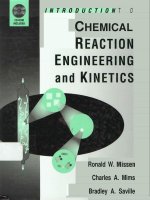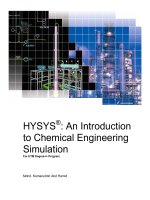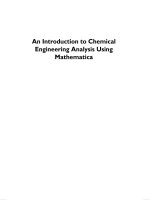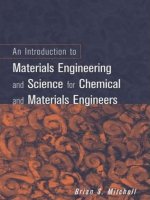Introduction to chemical principles
Bạn đang xem bản rút gọn của tài liệu. Xem và tải ngay bản đầy đủ của tài liệu tại đây (31.35 MB, 796 trang )
FLFVFNTH EDITION
INTRODUCTION TO
CH EM1CAL
PRINCIPLES
H. STEPHEN STOKER
www.pdfgrip.com
Periodic Table of the Elements
18
Group
VIIIA
1
Group
1A
1
2
Group
IIA
13
Group
IIIA
14
Group
IVA
15
Group
VA
17
Group
VIIA
4
5
6
7
16
Group
VIA
8
Li
Be
c
N
o
F
Ne
6.94
11
9.01
12
B
10.81
12.01
14
14.01
15
16.00
16
19.00
17
20.18
18
Na
Mg
22.99
19
24.31
20
23
24
25
26
27
28
29
-
K
Ca
Sc
Ti
V
Cr
Mn
Fe
Co
Ni
Cu
Zn
Ga
Ge
As
Se
Br
Kr
39.10
40.08
47.87
50.94
54.94
55.85
58.93
63.55
47
65.38
69.72
72.63
74.92
79.90
83.80
54
11
1.01
3
4
Group
IVB
3
Group
II1B
21
5
Group
VB
6
Group
VIB
7
Group
VIIB
8
9
Group
Group
-------- V11IB
10
Group
-------- ►
11
Group
IB
12
Group
I1B
9
He
4.00
10
Al
Si
P
s
Cl
Ar
26.98
31
28.09
30.97
33
32.06
34
35.45
35
39.95
36
37
38
44.96
39
40
41
52.00
42
43
44
45
58.69
46
48
49
50
51
78.96
52
Rb
Sr
Y
Zr
Nb
Mo
Tc
Ru
Rh
Pd
Ag
Cd
In
Sn
Sb
Te
I
Xe
85.47
55
87.62
56
88.91
9122
72
92.91
73
95.96
74
(98)
75
101.07
76
102.91
77
106.42
78
107.87
79
112.41
80
114.82
81
118.71
82
121.76
83
127.60
84
126.90
85
131.29
86
Cs
Ba
La
Hf
Ta
w
Re
Os
It
Pt
Au
Hg
Tl
Pb
Bi
Po
At
Rn
132.91
87
13733
88
138.91
89
178.49
104
180.95
105
183.84
106
186.21
107
190.23
108
192.22
109
195.08
110
196.97
111
200.59
112
204.38
113
207.2
114
208.98
115
(209)
116
(210)
117
(222)
118
Ac
Rf
(227) |
Db
sg
Bh
Hs
Mt
Ds
Rg
Cn
—
Fl
—
Lv
—
—
(268)
(271)
(272)
(270)
(276)
(281)
(280)
(285)
(284)
(289)
(288)
(293)
(293)
(294)
Nonmetals
Metals
58
59
60
61
62
63
64
65
66
67
68
69
70
71
Ce
Pr
Nd
Pm
Sm
Eu
Gd
Tb
Dy
Ho
Er
Yb
Lu
140.12
90
Th
140.91
91
Pa
144.24
(145)
93
Np
150.36
94
Pu
151.96
95
Am
15725
96
Cm
158.93
97
Bk
162.50
98
Cf
164.93
99
Es
167.26
100
Fm
1 111
168.93
101
Md
173.05
102
No
174.97
103
Lr
232.04
231.04
(237)
(244)
(243)
(247)
(247)
(251)
(252)
(257)
(258)
(259)
(262)
i es
Ra
(226)
1
£
Fr
(223)
57
53
www.pdfgrip.com
LIST OF ELEMENTS WITH THEIR SYMBOLS AND ATOMIC MASSES
Element
Actinium
Aluminum
Americium
Antimony
Argon
Arsenic
Astatine
Barium
Berkelium
Beryllium
Bismuth
Bohrium
Boron
Bromine
Cadmium
Calcium
Californium
Carbon
Cerium
Cesium
Chlorine
Chromium
Cobalt
Copernicium
Copper
Curium
Darmstadtium
Dubnium
Dysprosium
Einsteinium
Erbium
Europium
Fermium
Flerovium
Fluorine
Francium
Gadolinium
Gallium
Germanium
Gold
Hafnium
Hassium
Helium
Holmium
Hydrogen
Indium
Iodine
Iridium
Iron
Krypton
Lanthanum
Lawrencium
Lead
Lithium
Lutetium
Livermorium
Magnesium
Manganese
Meitnerium
Symbol
Atomic
Number
Atomic
Mass
Ac
Al
Am
Sb
Ar
As
At
Ba
Bk
Be
Bi
Bh
B
Br
Cd
Ca
Cf
C
Ce
Cs
Cl
Cr
Co
Cn
Cu
Cm
Ds
Db
Dy
Es
Er
Eu
Fm
Fl
F
Fr
Gd
Ga
Ge
Au
Hf
Hs
He
Ho
H
In
1
Ir
Fe
Kr
La
Lr
Pb
Li
Lu
Lv
Mg
Mn
Mt
89
13
95
51
18
33
85
56
97
4
83
107
5
35
48
20
98
6
58
55
17
24
27
112
29
96
110
105
66
99
68
63
100
114
9
87
64
31
32
79
72
108
2
67
1
49
53
77
26
36
57
103
82
3
71
116
12
25
109
(227)
26.98
(243)
121.76
39.95
74.92
(210)
137.33
(247)
9.012
208.98
(272)
10.81
79.90
112.41
40.08
(251)
12.01
140.12
132.91
35.45
52.00
58.93
(285)
63.55
(247)
(281)
(268)
162.50
(252)
167.26
151.96
(257)
(289)
19.00
(223)
157.25
69.72
72.63
196.97
178.49
(270)
4.003
164.93
1.008
114.82
126.90
192.22
55.85
83.80
138.91
(262)
207.2
6.941
174.97
(293)
24.31
54.94
(276)
Element
Mendelevium
Mercury
Molybdenum
Neodymium
Neon
Neptunium
Nickel
Niobium
Nitrogen
Nobelium
Osmium
Oxygen
Palladium
Phosphorus
Platinum
Plutonium
Polonium
Potassium
Praseodymium
Promethium
Protactinium
Radium
Radon
Rhenium
Rhodium
Roentgenium
Rubidium
Ruthenium
Rutherfordium
Samarium
Scandium
Seaborgium
Selenium
Silicon
Silver
Sodium
Strontium
Sulfur
Tantalum
Technetium
Tellurium
Terbium
Thallium
Thorium
Thulium
Tin
Titanium
Tungsten
Uranium
Vanadium
Xenon
Ytterbium
Yttrium
Zinc
Zirconium
Element 113
Element 115
Element 117
Element 118
Symbol
Atomic
Number
Md
Hg
Mo
Nd
Ne
Np
Ni
Nb
N
No
Os
O
Pd
P
Pt
Pu
Po
K
Pr
Pm
Pa
Ra
Rn
Re
Rh
Rg
Rb
Ru
Rf
Sm
Sc
Sg
Se
Si
Ag
Na
Sr
S
Ta
Tc
Te
Tb
n
Th
Tm
Sn
Ti
W
U
V
Xe
Yb
Y
Zn
Zr
—
—
—
—
101
80
42
60
10
93
28
41
7
102
76
8
46
15
78
94
84
19
59
61
91
88
86
75
45
111
37
44
104
62
21
106
34
14
47
11
38
16
73
43
52
65
81
90
69
50
22
74
92
23
54
70
39
30
40
113
115
117
118
Atomic
Mass
(258)
200.59
95.94
144.24
20.18
(237)
58.69
92.91
14.01
(259)
190.23
16.00
106.42
30.97
195.08
(244)
(209)
39.10
140.91
(145)
231.04
(226)
(222)
186.21
102.91
(280)
85.47
101.07
(267)
150.36
44.96
(271)
78.96
28.09
107.87
22.99
87.62
32.06
180.95
(98)
127.60
158.93
204.38
232.04
168.93
118.71
47.87
183.84
238.03
50.94
131.293
173.04
88.91
65.41
91.22
(284)
(288)
(293)
(294)
A mass value which is enclosed in parentheses is the mass number for the most stable isotope of an element that is laboratory produced rather than naturally
occurring.
www.pdfgrip.com
Eleventh Edition
Introduction to
Chemical Principles
www.pdfgrip.com
This page intentionally left blank
www.pdfgrip.com
Eleventh Edition
Introduction to
Chemical Principles
H. Stephen Stoker
Weber State University
PEARSON
Columbus Indianapolis New York San Francisco Upper Saddle River
Amsterdam Cape Town Dubai London .Madrid Milan Munich Paris Montreal Toronto
Delhi Mexico City Sao Paulo Sydney I long Kong Seoul Singapore Taipei Tokyo
Boston
www.pdfgrip.com
Editor in Chief: Adam Jaworski
Senior Marketing Manager: Jonathan Cottrell
Assistant Editor: Coleen Morrison
Editorial Assistant: Fran Falk
Marketing Assistant: Nicola Houston
Managing Editor, Chemistry and Geosciences: Gina M. Cheselka
Project Manager, Production: Connie Long
Full Service Project Management: Marie Desrosiers, PreMediaGlobal
Compositor: PreMediaGlobal
Text Permissions Manager: Joseph Croscup
Text Permissions Researcher: Jen Roach
Image Lead: Maya Melenchuk
Photo Researcher: Eric Schrader
Cover Designer: Seventeenth Street Studios
Operations Specialist: Jeffrey Sargent
Cover Image Credit: Shilova Ekaterina / Shutterstock
Credits and acknowledgments borrowed from other sources and reproduced, with permission, in this textbook
appear on the appropriate page within this book.
Copyright © 2014, 2011, 2008, 2005 Pearson Education. Inc. All rights reserved. Manufactured in the United
States of America. This publication is protected by Copyright, and permission should be obtained from the
publisher prior to any prohibited reproduction, storage in a retrieval system, or transmission in any form or by
any means: electronic, mechanical, photocopying, recording, or likewise. To obtain permission(s) to use
material from this work, please submit a written request to Pearson Education. Inc., Permissions Department.
1 Lake Street, Department 1G, Upper Saddle River. NJ 07458.
Many of the designations used by manufacturers and sellers to distinguish their products are claimed as
trademarks. Where those designations appear in this book, and the publisher was aware of a trademark claim,
the designations have been printed in initial caps or all caps.
Library of Congress Cataloging-in-Publication Data
Stoker, H. Stephen (Howard Stephen), 1939-
Introduction to chemical principles / H. Stephen Stoker. — 11th ed.
p. cm.
Includes index.
ISBN 978-0-321-81463-0
1. Chemistry. I. Title.
QD33-2.S76 2012
540—dc23
2012038211
12345 6 789 10—EB—16 15 14 13 12
PEARSON
www.pearsonhighered.com
ISBN-10: 0-321-81463-0: ISBN-13: 978-0-321-81463-0
www.pdfgrip.com
CONTENTS
Preface xiii
Acknowledgments xvi
Chapter 1
The Science of Chemistry
1.1
1.2
1.3
1.4
1
Chemistry—A Scientific Discipline
1
Scientific Research and Technology 3
The Scope of Chemistry 4
How Chemists Discover Things—The Scientific Method
Experiments, Observations, and Data 5
4
Scientific Facts 6
Scientific Laws 7
Scientific Hypotheses 7
Scientific Theories 8
1.5 The Limitations of the Scientific Method 10
1.6 Application Limitations for methods of Science 11
Concepts to Remember 11 • Key Terms Listing 12
Practice Problems By Topic 12 • Multiple-Choice Practice Test
Chapter 2
Numbers From Measurements
17
2.1 The Importance of Measurement
17
2.2
2.3
2.4
2.5
15
Exact and Inexact Numbers 18
Accuracy, Precision, and Error 18
Uncertainty in Measurements 20
Significant Figures 22
2.6 Significant Figures and Mathematical Operations 27
Rounding Off Numbers 27
Operational Rules for Mathematical Operations 29
Significant Figures and Exact Numbers 33
Multiplication by a Small Whole Number 33
2.7 Expressing Numbers in Scientific Notation 35
Exponents 36
Converting from Decimal to Scientific Notation 37
Significant Figures and Scientific Notation 38
Converting from Scientific to Decimal Notation 39
Uncertainty and Scientific Notation 40
2.8 Mathematical Operations in Scientific Notation 42
Multiplication in Scientific Notation 42
Division in Scientific Notation 44
Addition and Subtraction in Scientific Notation 45
Concepts to Remember 48 • Key Terms Listing 49
Practice Problems By Topic 49 • Multi-Concept Problems
Multiple Choice Practice Test 58
Chapter 3
Unit Systems and Dimensional Analysis
3.1 The Metric System of Units
60
SI Units 61
Metric System Prefixes 62
3.2 Metric Units of Length 63
3.3 Metric Units of Mass 64
3.4 Metric Units of Volume 65
3.5 Units in Mathematical Operations 68
60
57
www.pdfgrip.com
vi
Contents
Conversion Factors
3.6
68
English-to-English Conversion Factors
Metric-to-Metric Conversion Factors
69
69
Metric-to-English and English-to-Metric Conversion Factors
Dimensional Analysis
3.7
70
72
72
Metric-to-Metric Conversion Factor Use
English-to-English Conversion Factor Use
77
English-to-Metric and Metric-to-English Conversion Factor Use
Units Involving More Than One Type of Measurement
Density
3.8
82
83
Using Density as a Conversion Factor
86
Equivalence Conversion Factors Other than Density
3.9
88
Concentration and Dosage Relationship Conversion Factors
Rate Relationship Conversion Factors
89
Cost Relationship Conversion Factors
90
3.10
Percentage and Percent Error
Percent Error
88
91
Using Percentage as a Conversion Factor
3.11
78
92
95
Temperature Scales
96
Temperature Readings and Significant Figures 101
Concepts to Remember 101 • Key Terms Listing 102
Practice Problems By Topic 102 • Multi-Concept Problems
Multiple Choice Practice Test 109
Chapter 4
Basic Concepts About Matter
111
4.1
Chemistry—The Study of Matter
111
4.2
Physical States of Matter
4.3
Properties of Matter
112
113
Physical and Chemical Properties
114
Intensive and Extensive Properties
4.4
Changes in Matter
115
116
Use of the Terms Physical and Chemical
118
4.5
Pure Substances and Mixtures
4.6
Heterogeneous and Homogeneous Mixtures
119
120
Use of the Terms Homogeneous and Heterogeneous
4.7
4.8
Elements and Compounds
121
123
Discovery and Abundance of the Elements
126
■ THE HUMAN SIDE OF CHEMISTRY 1: Joseph Priestley (1733-1804)
4.9
108
Names and Chemical Symbols of the Elements
127
127
■ THE HUMAN SIDE OF CHEMISTRY 2: Jons Jakob Berzelius (1779-1848) 128
Concepts to Remember 131 • Key Terms Listing 132
Practice Problems By Topic 132 • Multi-Concept Problems 136
Multiple Choice Practice Test 137
Chapter 5
Atoms, Molecules, and Subatomic Particles
5.1
The Atom
140
140
■ THE HUMAN SIDE OF CHEMISTRY 3: John Dalton (1766-1844)
5.2
The Molecule
5.3
Natural and Synthetic Compounds
5.4
Chemical Formulas
5.5
143
146
147
Subatomic Particles: Protons, Neutrons, and Electrons 149
Arrangement of Subatomic Particles Within an Atom 150
Charge Neutrality of an Atom
151
Size Relationships within an Atom
Additional Subatomic Particles
152
151
141
www.pdfgrip.com
Contents
152
5.6 Atomic Number and Mass Number
Atomic Number
Mass Number
153
153
Subatomic Particle Makeup of an Atom
5.7 Isotopes
154
155
159
5.8 Atomic Masses
Relative Mass
159
161
Average Atom
Weighted Averages
162
Mass Spectrometry Experiments
165
5.9 Evidence Supporting the Existence and Arrangement of Subatomic Particles
Discharge Tube Experiments
Metal Foil Experiments
166
168
■ THE HUMAN SIDE OF CHEMISTRY 4: Ernest Rutherford (1871-1937) 169
Concepts to Remember 170 • Key Terms Listing 171
Practice Problems By Topic 171 • Multi-Concept Problems
Multiple Choice Practice Test 180
Chapter 6
Electronic Structure and Chemical Periodicity
6.1 The Periodic Law
178
182
182
6.2 The Periodic Table
183
■ THE HUMAN SIDE OF CHEMISTRY 5: Dmitri Ivanovich Mendeleev (1834-1907)
Periods and Groups of Elements
185
The Shape of the Periodic Table
187
6.3 The Energy of an Electron
188
■ THE HUMAN SIDE OF CHEMISTRY 6: Erwin Schrodinger (1887-1961)
190
190
6.4 Electron Shells
191
6.5 Electron Subshells
6.6 Electron Orbitals
Electron Spin
193
195
195
6.7 Electron Configurations
Aufbau Principle
195
Aufbau Diagram
196
Writing Electron Configurations
197
Condensed Electron Configurations
6.8 Electron Orbital Diagrams
199
201
6.9 Electron Configurations and the Periodic Law
204
6.10 Electron Configurations and the Periodic Table
6.12 Chemical Periodicity
205
211
6.11 Classification Systems for the Elements
213
Metallic and Nonmetallic Character
214
Atomic Size 215
Concepts to Remember 217 • Key Terms Listing 218
Practice Problems By Topic 218 • Multi-Concept Problems
Multiple Choice Practice Test 226
Chapter 7
185
Chemical Bonds
225
228
7.1 Types of Chemical Bonds
228
7.2 Valence Electrons and Lewis Symbols
229
■ THE HUMAN SIDE OF CHEMISTRY 7: Gilbert Newton Lewis (1875-1946)
7.3 The Octet Rule 233
7.4 The Ionic Bond Model
233
7.5 The Sign and Magnitude of Ionic Charge
Isoelectronic Species
236
238
7.6 Lewis Structures for Ionic Compounds
239
232
166
vii
www.pdfgrip.com
viii
Contents
7.7
Chemical Formulas for Ionic Compounds
7.8
Structure of Ionic Compounds
7.9
Polyatomic Ions
241
243
244
7.10 The Covalent Bond Model
246
7.11
Lewis Structures for Molecular Compounds
7.12
Single, Double, and Triple Covalent Bonds
7.13
Valence Electron Count and Number of Covalent Bonds Formed
7.14
Coordinate Covalent Bonds
7.15
Resonance Structures
7.16
Systematic Procedures for Drawing Lewis Structures
7.17
Molecular Geometry
247
250
254
263
Molecules with Two VSEPR Electron Groups
263
Molecules with Three VSEPR Electron Groups
Molecules with Four VSEPR Electron Groups
Electronegativity
255
261
Electron Pairs versus Electron Groups
7.18
264
265
268
■ THE HUMAN SIDE OF CHEMISTRY 8: Linus Carl Pauling (1901-1994)
Chapter 8
268
7.19
Bond Polarity
7.20
Molecular Polarity 273
Concepts to Remember 276 • Key Terms Listing 278
Practice Problems By Topic 278 • Multi-Concept Problems
Multiple Choice Practice Test 289
270
Chemical Nomenclature
8.1
Classification of Compounds for Nomenclature Purposes
8.2
Typesof Binary Ionic Compounds
8.3
Nomenclaturefor Binary Ionic Compounds
291
292
Fixed-Charge Binary Ionic Compounds
294
295
297
8.4
Chemical Formulas for Polyatomic Ions
8.5
Nomenclature for Ionic Compounds Containing Polyatomic Ions
8.6
301
Nomenclaturefor Binary Molecular Compounds
Common Names for Binary Molecular Compounds
8.7 Nomenclature for Acids
8.8
287
291
Variable-Charge Binary Ionic Compounds
Chapter 9
251
252
303
306
308
309
Systematic Procedures for Using Nomenclature Rules 314
Concepts to Remember 317 • Key Terms Listing 318
Practice Problems By Topic 318 • Multi-Concept Problems
Multiple Choice Practice Test 325
324
Chemical Calculations: The Mole Concept
and Chemical Formulas 327
9.1 The Law of Definite Proportions
327
■ THE HUMAN SIDE OF CHEMISTRY 9: Joseph-Louis Proust (1754-1826)
9.2
Calculation of Formula Masses
9.3
Significant Figures and Formula Mass
9.4
Mass Percent Composition of a Compound
9.5
The Mole: The Chemist's Counting Unit
328
331
333
335
337
■ THE HUMAN SIDE OF CHEMISTRY 10: Lorenzo Romano Amedeo Carlo Avogadro
(1776-1856)
9.6
339
The Mass of a Mole
341
Summary of Mass Terminology
346
9.7
Significant Figures and Avogadro's Number
9.8
Relationship Between Atomic Mass Units and Gram Units
9.9
The Mole and Chemical Formulas
348
347
347
www.pdfgrip.com
Contents
9.10
The Mole and Chemical Calculations
9.11 Purity of Samples
351
358
361
9.12
Empirical and Molecular Formulas
9.13
Determination of Empirical Formulas
362
Empirical Formulas from Direct Analysis Data
363
Empirical Formulas from Indirect Analysis Data
9.14
Chapter 10
366
Determination of Molecular Formulas 370
Concepts to Remember 375 • Key Terms Listing 375
Practice Problems By Topic 376 • Multi-Concept Problems
Multiple Choice Practice Test 385
Chemical Calculations Involving Chemical Equations
10.1
The Law of Conservation of Mass
387
387
■ THE HUMAN SIDE OF CHEMISTRY 11: Antoine-Laurent Lavoisier (1743-1794)
10.2
Writing Chemical Equations
10.3
Chemical Equation Coefficients
10.4
Balancing Procedures for Chemical Equations
10.5
Special Symbols Used in Chemical Equations
10.6
Classes of Chemical Reactions
Synthesis Reactions
388
389
390
392
397
398
398
Decomposition Reactions
399
Single-Replacement Reactions
399
Double-Replacement Reactions
400
401
Combustion Reactions
10.7
Chemical Equations and the Mole Concept
10.8
Balanced Chemical Equations and the Law of Conservation of Mass
10.9
Calculations Based on Chemical Equations—Stoichiometry
10.10
384
The Limiting Reactant Concept
403
406
407
413
10.11 Yields: Theoretical, Actual, and Percent
418
10.12 Simultaneous and Sequential Chemical Reactions 421
Combining Sequential Chemical Reaction Equations into a Single Overall Chemical
Reaction Equation 423
Concepts to Remember 425 • Key Terms Listing 425
Practice Problems By Topic 426 • Multi-Concept Problems
Multiple Choice Practice Test 436
Chapter 11
States of Matter
439
11.1
Factors that Determine Physical State
11.2
Property Differences among Physical States
11.3
The Kinetic Molecular Theory of Matter
11.4
The Solid State
11.5
The Liquid State
11.6
The Gaseous State
11.7
A Comparison of Solids, Liquids, and Gases
11.8
Endothermic and Exothermic Changes of State
11.9
Heat Energy and Specific Heat
Heat Energy Units
439
441
442
443
444
444
445
446
447
447
Specific Heat 449
11.10
Temperature Changes as a Substance is Heated
11.11 Energy and Changes of State
11.12 Heat Energy Calculations
11.13 Evaporation of Liquids
454
457
461
Rate of Evaporation and Temperature
Evaporation and Equilibrium
463
462
453
435
ix
www.pdfgrip.com
X
Contents
11.14 Vapor Pressure of Liquids
464
11.15 Boiling and Boiling Points
465
Factors that Affect Boiling Point
466
11.16 Intermolecular Forces in Liquids
Dipole-Dipole Interactions
Hydrogen Bonds
London Forces
467
468
468
471
Ion-Dipole Interactions
472
472
Ion-Ion Interactions
11.17 Hydrogen Bonding and The Properties of Water
473
Vapor Pressure
Thermal Properties
Density
473
473
475
Surface Tension 477
Concepts to Remember 477 • Key Terms Listing 478
Practice Problems By Topic 479 • Multi-Concept Problems
Multiple Choice Practice Test 486
Chapter 12
Gas Laws
485
488
12.1 Properties of Some Common Gases
12.2 Gas Law Variables
488
489
Pressure Readings and Significant Figures
493
12.3 Boyle's Law: A Pressure-Volume Relationship
494
■ THE HUMAN SIDE OF CHEMISTRY 12: Robert Boyle (1627-1691)
12.4 Charles's Law: A Temperature-Volume Relationship
494
498
■ THE HUMAN SIDE OF CHEMISTRY 13: Jacques Alexandre Cesar Charles (1746-1823)
12.5 Gay-Lussac's Law: A Temperature-Pressure Relationship
502
■ THE HUMAN SIDE OF CHEMISTRY 14: Joseph Louis Gay-Lussac (1778-1850)
12.6 The Combined Gas Law
12.7 Avogadro's Law
12.8 An Ideal Gas
504
507
511
12.9 The Ideal Gas Law
511
12.10 Modified Forms of the Ideal Gas Law Equation
The Molar Mass of a Gas
The Density of a Gas
516
516
518
Using Density to Calculate Molar Mass
519
12.11 Volumes of Gases in Chemical Reactions
520
12.12 Volumes of Gases and the Limiting Reactant Concept
12.13 Molar Volume of a Gas
Using Molar Volume to Calculate Density
527
528
12.14 Chemical Calculations Using Molar Volume
12.15 Mixtures of Gases
523
525
Standard Temperature and Standard Pressure Conditions
530
537
12.16 Dalton's Law of Partial Pressures 538
Concepts to Remember 547 • Key Terms Listing 548
Practice Problems By Topic 549 • Multi-Concept Problems
Multiple Choice Practice Test 561
Chapter 13
Solutions
564
13.1 Characteristics of Solutions
13.2 Solubility
502
564
566
Effect of Temperature on Solubility
Effect of Pressure on Solubility
566
567
Terminology for Relative Amount of Solute in a Solution
Aqueous and Nonaqueous Solutions
568
567
560
499
www.pdfgrip.com
Contents
13.3
568
Solution Formation
Factors Affecting the Rate of Solution Formation
13.4
Solubility Rules
13.5
Solution Concentrations
13.6
Percentage Concentration Unit
569
569
571
571
Using Percent Concentrations as Conversion Factors
575
13.7
Parts Per Million and Parts Per Billion Concentration Units
13.8
Molarity Concentration Unit
Using Molarity as a Conversion Factor
13.9
13.10
582
Molarity and Chemical Reactions in Aqueous Solution
Dilution Calculations
578
581
588
592
13.11 Molality Concentration Unit 596
Concepts to Remember 602 • Key Terms Listing 603
Practice Problems By Topic 603 • Multi-Concept Problems
Multiple Choice Practice Test 613
Chapter 14
Acids, Bases, and Salts
14.1
612
616
Arrhenius Acid-Base Theory
616
■ THE HUMAN SIDE OF CHEMISTRY 15: Svante August Arrhenius
(1859-1927) 617
14.2
Bronsted-Lowry Acid-Base Theory
618
Generalizations about Bronsted-Lowry Acids and Bronsted-Lowry Bases
14.3
Amphiprotic Substances
623
14.4
Mono-, Di-, and Triprotic Acids
14.5
Strengths of Acidsand Bases
14.6
Salts
14.7
Reactions of Acids
629
Reaction with Metals
629
623
625
628
Reaction with Bases
629
Reaction with Carbonates and Bicarbonates
14.8
Reactions of Bases
14.9
Reactions of Salts
631
631
631
Reaction with Metals
632
Reaction with Acids
632
Reaction with Bases
633
Reaction of Salts with Each Other
14.10
Self-Ionization of Water
633
635
Ion Product Constant for Water
636
Effect of Solutes on Water Self-Ionization
636
Effect of Temperature Change on Water Self-Ionization
Acidic, Basic, and Neutral Solutions
14.11 The pH Scale
Integral pH Values
638
639
14.12 Hydrolysis of Salts
Types of Salt Hydrolysis
640
644
645
Chemical Equations for Salt Hydrolysis Reactions
14.13 Buffers
637
638
Nonintegral pH Values
646
648
Chemical Equations for Buffer Action
14.14
620
621
Conjugate Acids and Bases
649
Acid-Base Titrations 651
Concepts to Remember 653 • Key Terms Listing 654
Practice Problems By Topic 654 • Multi-Concept Problems
Multiple Choice Practice Test 663
661
xi
www.pdfgrip.com
xii
Contents
Chapter 15
Chapter 16
Chemical Equations: Net Ionic and Oxidation-Reduction
15.1
Types of Chemical Equations
15.2
Electrolytes
15.3
Ionic and Net Ionic Equations
15.4
Oxidation-Reduction Terminology
15.5
Oxidation Numbers
15.6
Redox and Nonredox Chemical Reactions
15.7
Balancing Oxidation-Reduction Equations
15.8
Oxidation Number Method for Balancing Redox Equations
15.9
Half-Reaction Method for Balancing Redox Equations
665
666
667
671
673
678
680
681
686
15.10
Disproportionation Reactions
15.11
Stoichiometric Calculations Involving Ions 696
Concepts to Remember 699 • Key Terms Listing 700
Practice Problems By Topic 700 • Multi-Concept Problems
Multiple-Choice Practice Test 707
692
Reaction Rates and Chemical Equilibrium
16.1
Activation Energy
710
711
711
Collision Orientation
711
16.2
Endothermic and Exothermic Chemical Reactions
16.3
Factors that Influence Chemical Reaction Rates
Physical Nature of Reactants
Reactant Concentration
Presence of Catalysts
712
713
714
714
Reaction Temperature
714
715
16.4
Chemical Equilibrium
16.5
Equilibrium Mixture Stoichiometry
16.6
Equilibrium Constants
16.7
Equilibrium Position
16.8
Temperature Dependency of Equilibrium Constants
16.9
Le Chatelier's Principle
716
717
719
722
Concentration Changes
723
724
724
■ THE HUMAN SIDE OF CHEMISTRY 16: Henri-Louis Le Chatelier (1850-1936)
Temperature Changes
Pressure Changes
727
Forcing Chemical Reactions to Completion 728
Concepts to Remember 729 • Key Terms Listing 729
Practice Problems By Topic 730 • Multi-Concept Problems
Multiple Choice Practice Test 736
739
Answers to Odd-Numbered Practice Problems
Credits
Index
763
764
725
726
726
Addition of a Catalyst
Glossary
706
710
Collision Theory
Molecular Collisions
16.10
665
748
735
www.pdfgrip.com
PREFACE
Introduction to Chemical Principles is a text for students who have had little or no previous instruction in
chemistry' or whose instruction was so long ago that a thorough review is needed. The text’s purpose is to
give students the background (and confidence) needed for a subsequent successful encounter with a main
sequence, college-level, general chemistry course.
Many texts written for preparatory’ chemistry courses are simply watered-down versions of general
chemistry' texts: They' treat almost all topics found in the general chemistry' course, but at a superficial
level. Introduction to Chemical Principles does not fit this mold. My philosophy' is that it is better to treat
fewer topics extensively and have the student understand those topics in greater depth. I resisted the very’
real temptation to include lots of additional concepts in this new edition. Instead, my focus for this edition
was on rewriting selected portions to improve the clarity of presentation.
NEW FEATURES OF THE ELEVENTH EDITION
• “Chemical Insights” are used to bridge the gap between mathematics and chemistry. This
new “insight” feature, which is appended to many of the worked-out example problems in the text that
involve calculations, focuses on the element or compound that is the subject of the calculation. These
insights give information on the subject element’s/compound’s occurrence, its properties and uses, its
relationship to the environment, its relationship to living systems (biochemistry’), and so on. It is easy
for students to become so involved in the mathematics of problem solving that they completely’ forget
about the “realness” of the type of matter that is the subject of the calculation. There are 85 total insights
which address this “realness” issue.
• A “Student Learning Focus” feature is used as a mini study guide for students. These learning
objectives, found at the start of all sections of all chapters, “pinpoint” for the student what it is hoped
they will gain by study of the given section.
• New Worked-Out Example Problems. Nineteen of the 236 worked-out example problems in the
text are new. Worked-out-in-detail example problems with their extensive commentary’ constitute
one of the greatest strengths of the text.
• Extensive revision of “End-of-Chapter Problem Sets.” Although the total number of end-ofchapter problems, which already exceeds that of most other similar texts, has not increased signifi
cantly, almost 500 of the previous edition’s 2200 problems have lx?en replaced with new problems.
A special effort was made to create new problems that address specifically the “core concepts” as
sociated with a given chapter section’s subject matter. In most chapters several of the newly’ added
problems involve presentation of data in a “visual form” rather than in a “sentence form.” Many of the
“visual problems” involve situations where reasoning, with little or no calculation, is needed to test a
student’s grasp of a key concept.
Content changes to individual chapters. After ten successful editions of Introduction to Chemical
Principles, the need for drastic alterations in chapter ordering and chapter content does not exist. Changes
that have l)een made relate to “fine tuning" of the presentation of the subject matter. Among the most impor
tant changes to this edition are the following:
• Chapters 4 and 5: The last four sections of chapter 4 of the previous edition (atoms, molecules,
and chemical formulas) has been moved to the start of Chapter 5. Material concerning unstable
nuclei previously' found in chapter 5 has been deleted
• Chapter 13: Material dealing with the use of the molarity' concentration unit in chemical calculations
now immediately follows the introduction of the concept of molarity’. Previously this material was
found at the end of the chapter.
xiii
www.pdfgrip.com
xiv
Preface
IMPORTANT CONTINUING FEATURES IN THE ELEVENTH EDITION
1. Development of each topic starts out at ground level. Because of the varied degrees of under
2.
3.
4.
5.
6.
7.
8.
standing of chemical principles possessed by students taking a preparatory chemistry' course, each
topic is developed step by' step from ground level until the level of sophistication required for a
further chemistry' course is attained.
Problem-solving pedagogy is based on dimensional analysis. Over forty years of reaching
experience suggest to me that student “troubles” in general chemistry courses are almost always cen
tered on the inability’ to set up and solve problems. Whenever possible, I use dimensional analysis in
problem solving. This method, which requires no mathematics beyond arithmetic and elementary al
gebra, is a powerful and widely' applicable problem-solving tool. Most important, it is a method that
an average student can master with an average amount of diligence. Mastering dimensional analysis
also helps build the confidence that is so valuable for future chemistry courses.
Detailed commentary accompanies all worked-out example problems. In all chapters, one or
more worked-out example problems follow the presentation of key' concepts. These examples walk
students through the thought processes involved in solving the particular type of problem. Detailed
commentary accompanies all of the steps involved in solving a problem.
“Answer Double Check” feature. Over half (60%) of the texts worked-out examples are enhanced
by’ the feature called “answer double check.” The purpose of this feature, which is appended to the end
of the worked-out example discussion, is to encourage students to consider whether the answer they
obtain in working a problem is a reasonable answer in terms of items such as numerical magnitude,
number of significant figures present, sign convention (plus or minus), and direction of change (increase
or descrease). An unreasonable answer is often a sign that a calculator error has been made.
Significant-figure concepts are emphasized in all problem-solving situations. Routinely,
electronic calculators display’ answers that contain more digits than are needed or acceptable. In all
worked-out examples, students are reminded about these unneeded digits by the appearance of two
answers to the example: the calculator answer (which does not take into account significant figures)
and, in color, the correct answer (which is the calculator answer adjusted to the correct number of
significant figures).
Operation rules for standardizing uncertainty in numbers are used. Students often experi
ence a relatively' high degree of frustration when they correctly solve a problem and yet obtain an
answer that differs slightly from the one given in the answer section at the back of the book. They
want to get the exact number shown in the answer section. Most often the discrepancy is due to
differing degrees of uncertainty in the input numbers used for the calculation, for example, in mo
lecular mass values. To minimize such frustration, operational rules have been introduced for stan
dardizing uncertainty' in input numbers. The standard mode of operation is always (1) to round all
atomic masses to hundredths before using them in molecular mass calculations, and (2) to specify'
frequently used numbers, such as Avogadro’s number, molar volume, and the ideal gas constant to
four significant figures. Using these operational rules for input numbers, student answers will match
the back-of-the-book answers to the last significant digit.
Defined terms always appear in self-standing complete sentences. All definitions are high
lighted in the text when they are first presented, using boldface and italic type. Each defined term
appears as a complete sentence; students are never required to deduce a definition from context. In
addition, the definitions of all terms appear in a separate glossary’ found at the end of the text. All
defined terms have been reexamined to see if they could be stated with greater clarity’. The result is
a rewording of many defined terms. In addition, the number of defined terms has been increased.
There are 29 new or modified definitions in this new edition of the text.
All end-of-chapter exercises occur in matched pairs. In essence, each chapter has two inde
pendent, but similar, problem sets. Counting subparts to problems, there are over 5000 questions
and problems available for students to use in their journey to proficient problem solving. Answers
to all of the odd-numbered problems are found at the end of the text. Thus, two problem sets exist,
one with answers and one without.
www.pdfgrip.com
Preface
9- “Multiple-Choice Practice Test” feature. The emphasis in this text has always l>een and still is
on working problems from scratch. Some, but certainly not all instructors, use this same approach
when giving class examinations. A multiple-choice question examination is another common type
of examination given. To aid students whose examinations involve multiple-choice examinations,
a 20-question "multiple-choice practice test” in included as the last feature in each chapter. It is in
tended that students use this feature as an aid in reviewing subject matter for an upcoming multiple
choice examination.
10. Historical vignettes are used to address some of the “people aspects” of chemistry. These
vignettes, entitled "The Human Side of Chemistry,” are brief biographies of scientists who helped de
velop the foundations of modern chemistry. In courses such as the one for which this text is written,
it is very easy for students to completely lose any feeling for the people involved in the development
of the subject matter they are considering. If it were not for the contributions of these people, many
of whom worked under adverse conditions, chemistry would not be the central science that it is
today.
11. Marginal notes are used extensively. The two main functions of the marginal notes are (1) to
summarize key concepts and often give help for remembering concepts or distinguishing between
similar concepts, and (2) to provide additional details, links between concepts, or historical informa
tion about the concepts under discussion.
SUPPLEMENTS
For the Instructor
Instructor Solutions Manual (download only): (ISBN: 0321815130) by Nancy J. Gardner, California
State University-Long Beach. Contains full solutions to all of the end-of-chapter problems in the text.
TestGen Computerized Test Bank: (ISBN: 0321815319) by Pamela Kerrigan, Mount Saint Vincent.
Contains approximately 1000 multiple-choice and short-answer questions, all referenced to the text.
CourseSmart: (ISBN: 0321815149) Access your college textlxxjk in online format at www.coursesmart.com .
For the Student
Student Solutions Manual: (ISBN: 0321815122) by Nancy J. Gardner, California State University-
Long Beach. Includes full solutions to all odd-numbered end-of-chapter problems and answers to all mul
tiple choice practice test questions in the text.
xv
www.pdfgrip.com
ACKNOWLEDGMENTS
I d like to gratefully acknowledge the valuable contributions of my accuracy reviewer Andreas Lippert of
Welder State University.
Every effort has been made to rid this text of any typographical errors. I encourage my read
ers who notice anything suspicious, or who have other questions or comments, to e-mail me at the
address below.
H. Stephen Stoker
e-mail:
Reviewers of the Eleventh Edition of Introduction to Chemical Principles, Stoker
Kiran Kuar
Joel Case
University of Wisconsin
Solano Community College
Lisa Devane
Kent Lau
Bladen Community College
San Francisco State University
Reviewers of the Tenth Edition of Introduction to Chemical Principles, Stoker
John M. Allen,
Ann van Heerden,
Indiana State University
Lonesta r College-C)Fa ir
Virginia Lea Miller,
Ashton T. Griffin,
Wayne Community College
Montgomery College
Lisa DeVane,
Douglas S. Cody,
Bladen Community College
Nassau Community College
Charles Spillner,
Andreas Lippert,
Solano Community College
Weber State University
Todd M. Johnson,
Weber State University
xvi
www.pdfgrip.com
The Science of Chemistry
1.1
Chemistry—A Scientific Discipline
1.2
Scientific Research and Technology
The Scope of Chemistry
How Chemists Discover Things—The Scientific Method
The Limitations of the Scientific Method
Application Limitations for Methods of Science
1.3
1.4
1.5
1.6
1.1 CHEMISTRY—A SCIENTIFIC DISCIPLINE
Student Learning Focus: Understand the relationship of the scientific discipline called chemistry to
other scientific disciplines and be familiar with the sub-structuring that occurs with the discipline
of chemistry.
Chemistry is part of a larger body of knowledge called science. Science is the study in
which humans attempt to organize and explain, in a systematic and logical manner,
knowledge about themselves and their surroundings.
Because of the enormous scope of science, rhe sheer amount of accumulated
knowledge, and the limitations of human mental capacity to master such a large and
diverse body of knowledge, science is divided into smaller subdivisions called scientific
disciplines. A scientific discipline fs a branch of science limited in size and scope to
make it more manageable. Examples of scientific disciplines are chemistry, astronomy,
botany, geology, physics, and zoology.
Figure 1.1 shows an organizational chart, with emphasis on chemistry, for the vari
ous scientific disciplines. These disciplines can be grouped into physical sciences (the
study of matter and energy) and biological sciences (the study of living organisms).
Chemistry is a physical science.
Rigid boundaries between scientific disciplines do not exist. All scientific disciplines
borrow information and methods from each other. No scientific discipline is totally inde
pendent. Environmental problems that scientists have encountered in the last two decades
1
www.pdfgrip.com
2
Chapter 1 • The Science of Chemistry’
An
organizational
chart showing the
relationship of the
scientific discipline
called chemistry
to other scientific
disciplines and also
the sub-structuring
that occurs within the
discipline of chemistry.
FIGURE 1.1
Biological Sciences
Study of Living Organisms
Physical Sciences
Study of Matter and Energy
Analytical
General
Inorganic
Organic
Physical
Noncarboncontaining
substances
Carboncontaining
substances
Energy
changes
1
1
Analysis
and
composition
Fundamental
laws
and concepts
particularly show the interdependence of the various scientific disciplines. For example,
chemists attempting to solve the problems of chemical contamination of the environment
find that they need some knowledge of geology, zoology, and botany. It is now common
to talk not only of chemists, but also of geochemists, biochemists, chemical physicists,
and so on. The middle portion of Figure 1.1 shows the overlap of the other scientific dis
ciplines with chemistry.
Discipline overlap requires that scientists, in addition to having in-depth knowledge
of a selected discipline, also have limited knowledge of other disciplines. Discipline over
lap also explains why a great many college students are required to study chemistry. One
or more chemistry courses are required because of their applicability to the disciplines in
which the student has more specific interest.
The body' of knowledge found within the scientific discipline of chemistry is itself
vast. No one can hope to master completely all aspects of chemical knowledge. However,
the fundamental concepts of chemistry can be learned in a relatively’ short period of time.
The vastness of chemistry’ is sufficiently large that it. like most scientific disciplines,
is partitioned into subdisciplines. The lower portion of Figure 1.1 shows the five funda
mental branches of chemistry: analytical, general, inorganic, organic, and physical. Most
of the subject matter of this textbook falls within the realm of general chemistry, the fun
damental laws and concepts of chemistry.
The American Chemical Society’ (ACS) is the largest scientific organization in the
world. Examination of the names of the 33 subdivisions of ACS (see Table 1.1) further
www.pdfgrip.com
Chapter 1 • The Science of Chemistry
TABLE 1.1 Names of the Divisions of the American Chemical Society
Agricultural and Food Chemistry
Fluorine Chemistry
Agrochemicals
Fuel Chemistry
Analytical Chemistry
Geochemistry
Biochemical Technology
History of Chemistry
Biological Chemistry
Industrial and Engineering Chemistry
Business Development and Management
Inorganic Chemistry
Carbohydrate Chemistry
Medicinal Chemistry
Catalysis Science and Technology
Nuclear Chemistry and Technology
Cellulose and Renewable Materials
Organic Chemistry
Chemical Education
Petroleum Chemistry
Chemical Health and Safety
Physical Chemistry
Chemical Information
Polymer Chemistry
Chemical Toxicology
Polymeric Materials: Science and Engineering
Chemistry and the Law
Professional Relations
Colloid and Surface Science
Rubber
Computers in Chemistry
Small Chemical Businesses
Environmental Chemistry
illustrates the wide diversity of subject matter and activities encompassed within the dis
cipline of chemistry.
1.2 SCIENTIFIC RESEARCH AND TECHNOLOGY
Student Learning Focus: Understand how the fields of basic scientific research and applied sci
entific research differ from each other and how the concepts of applied chemical research and
technology are related.
The basic activity through which new knowledge is added to rhe various scientific disci
plines, including chemistry, is that of scientific research. Scientific research is the pro
cess of methodical investigation into a subject in order to discover new information about
the subject. There are two general types of scientific research—basic and applied. Basic
scientific research is research whose major focus is the discovery of new fundamental
information about humans and other living organisms and the universe in which they
live. The number of scientists involved in basic scientific research is small compared to
those involved in applied scientific research. Most scientists function in the area of ap
plied scientific research. Applied chemical research is research whose majorfocus is the
discovery ofproducts and processes that can be used to benefit humankind.
In many ways, basic scientific research is the precursor to applied scientific research.
The former is the lifeline that supplies the latter with new ideas on which to work. No
change in quality of life results from basic scientific research endeavors unless something
is done with the body of information that accumulates. Use of this information for the
betterment of humankind is the role of applied chemical research and the ensuing tech
nology that results from it. Technology is the application of applied chemical research to
the production of new products to improve human survival, comfort, and quality of life.
3
www.pdfgrip.com
4
Chapter 1 • The Science of Chemistry’
Whether or not a given
piece of scientific knowl
edge is technologically
used for beneficial or
detrimental purposes de
pends on the motives of
those men and women,
whether in industry or
government, who have
the decision-making
authority. In democratic
societies, citizens (the
voters) can influence
many technological
decisions. It is important
for citizens to become
informed about scientific
and technological issues.
Technological advances began affecting our society' more than 200 years ago, and new
advances still continue, at an accelerating pace, to have a major impact on human society’.
Both benefits and detriments can be obtained from the same piece of scientific
knowledge, depending on the technology used to put it to work. For example, knowledge
concerning the closely’ related structures of the naturally-occurring substances morphine
and codeine, obtained through basic research, has led to the development of several im
portant codeine-derivatives currently used in modern medicine as prescription painkillers
(hydrocodone and oxycodone) as well as the synthesis of the illegal drug heroin, whose
structure parallels closely that of morphine.
1.3 THE SCOPE OF CHEMISTRY
Student Learning Focus: Be able to list several areas in which chemistry applications are important
to human beings.
Although chemistry is concerned with only a part of the scientific knowledge that has
been accumulated, it is in itself an enormous and broad field. Chemistry’ touches all parts
of our lives.
Many’ of the clothes we wear are made from synthetic fibers produced by chemical
processes. Even natural fibers, such as cotton or wool, are the products of naturally’ occur
ring chemical reactions within living systems. Our transportation usually involves vehicles
powered with energy obtained by burning chemical mixtures such as gasoline or diesel
and jet fuels. The drugs used to cure many’ of our illnesses are the result of chemical re
search. The paper on which this textbook is printed was produced through a chemical
process, and the ink used in printing the words and illustrations is a mixture of many
chemicals. Almost all of our recreational pursuits involve objects made of materials pro
duced by’ chemical industries. Skis, boats, basketballs, bowling balls, musical instruments,
and television sets all contain materials that do not occur naturally, but are products of
human technological expertise.
Our bodies are a complex mixture of chemicals. The principles of chemistry are
fundamental to an understanding of all processes of the living state. Chemical secretions
(hormones) produced within our bodies help determine our outward physical character
istics such as height, weight, and appearance. Digestion of food involves a complex series
of chemical reactions. Food itself is an extremely complicated array of chemical sub
stances. Chemical reactions govern our thought processes and how knowledge is stored
in and retrieved from our brains. In short, chemistry’ runs our lives.
A formal course in chemistry’ can be a fascinating experience because it helps us
understand ourselves and our surroundings. We cannot truly understand or even knowvery’ much about the world we live in or about our own bodies without being conversant
with the fundamental ideas of chemistry.
1.4 HOW CHEMISTS DISCOVER THINGS—THE SCIENTIFIC METHOD
Student Learning Focus: List procedural steps associated with the problem-solving approach called
the scientific method and distinguish among the terms experiment, scientific fact, scientific law,
scientific hypothesis, and scientific theory.
There is no one single correct way to do scientific research, be it basic or applied
(Sec. 1.2). Different scientists often have different approaches to solving the same
problem. However, the various approaches used always have embodied within them
a number of common characteristics that constitute the problem-solving approach
known as the scientific method.
www.pdfgrip.com
Chapter 1 • The Science of Chemistry
5
The scientific method is a set ofgeneral procedures based on experimentation and
observation used to acquire scientific knowledge and explain natural phenomena. The
procedural steps in the scientific method are as follows:
1. Identify the problem, break it into small parts, and carefully plan procedures to ob
tain information about all aspects of this problem.
2. Collect data concerning the problem through observation and experimentation (see
Figure 1.2).
3. Analyze and organize the data in terms of general statements (generalizations) that
summarize the experimental observations.
4. Suggest probable explanations for the generalizations.
5. Experiment further to prove or disprove the proposed explanations.
Although two different
scientists rarely approach
the same problem in ex
actly the same way, there
are always similarities in
their approaches. These
similarities are the proce
dures associated with the
scientific method.
On occasion, a great discovery is made by accident, but the majority of scientific
discoveries are the result of the application of these five steps over long periods of
time. There are no instantaneous steps in the scientific method: applying them requires
considerable amounts of time. Even in those situations where luck is involved, it must
be remembered that chance favors the prepared mind. To take full advantage of an
accidental discovery, a person must be well trained in the procedures of the scientific
method.
The imagination, creativity, and mental attitude of a scientist using the scientific
method are always major factors in scientific success. The procedures of the scientific
method must always be enhanced with the abilities of a thinking scientist.
There are special vocabulary terms associated with the scientific method and its use.
This vocabulary includes the terms experiment, scientific fact, scientific law, scientific
hypothesis, and scientific theory. An understanding of the relationships among these terms
is the key to a real understanding of how to obtain chemical knowledge.
Experiments, Observations, and Data
The beginning step in the search for chemical knowledge is the identification of an as
pect of a chemical system that needs study. After determining what other chemists have
already learned about the selected situation, a chemist sets up experiments for obtaining
FIGURE 1.2 Chemistry
is an experimental
science. Most
discoveries in
chemistry are made
through analysis of
data obtained from
experiments carried
out in laboratories.
(iStockphoto)
www.pdfgrip.com
6
Chapter 1 • The Science of Chemistry’
more information. An experiment is a well-defined, controlled procedure for obtaining
information about a system under study.
Performing an experiment involves making careful observations about a system
under study. An observation is a statement that describes something we see, hear, smell,
taste, or feel. Instrumentation is most often used as an aid in making observations.
Observations obtained while performing an experiment are called data. Such data may’
lx? qualitative or quantitative, with the latter being preferred. Qualitative data is nonnu merical data consisting of general observations about a system under study. The ob
servation that ice is less dense than liquid water is an example of qualitative information
about a system. Quantitative data is numerical data obtained by various measurements
on a system under study. The information that ice has a density of 0.9170 grams per cubic
centimeter at 0°C whereas liquid water has a density’ of 0.9999 grams per cubic centimeter
at the same temperature represents quantitative data. Quantitative observations are more
useful than qualitative ones because they can be compared with each other and trends or
patterns in information can be seen.
An experiment typically involves study’ of at least two quantities, that is, variables
that have changing values. Usually, the effect of change in one variable on another vari
able, with all other variables held constant, is measured. For example, the effect that
temperature change has on the density’ of a fixed quantity’ of a gas, with pressure held
constant, can be measured.
A well-designed experiment is always performed under controlled conditions, that
is, the values of all variables are always noted, not just those that are changing. When
such is the case, the experimental data can be reproduced, if needed, by repeating the
experiment.
EXAMPLE 1.1
Distinguishing between Qualitative
and Quantitative Data
Classify each of the following pieces of information as qualitative data or quan
titative data.
a. The patient’s high fever has reached 105.3°F.
b. The cricket is chirping more loudly’ tonight than last night.
c. The package of candy contains about 200 gummi bears.
SOLUTION
a. Quantitative data—the temperature was measured with a thermometer.
b. Qualitative data—no measurement was made.
c. Qualitative data—even though a number is specified, it is an estimated number
rather than a measured number.
Scientific Facts
The individual pieces of new information (data) about a system under study, obtained
by carrying out experimental procedures, are called scientific facts. A scientific fact
is a reproducible piece of data about some natural phenomenon that is obtained from
experimentation. Note the word reproducible in this definition. If a given experiment is
repeated under exactly the same conditions, the same results (scientific facts) should be
obtained. To be acceptable, all scientific facts must be verifiable by anyone who has the
time, means, and knowledge needed to repeat the experiments that led to their discovery’.









